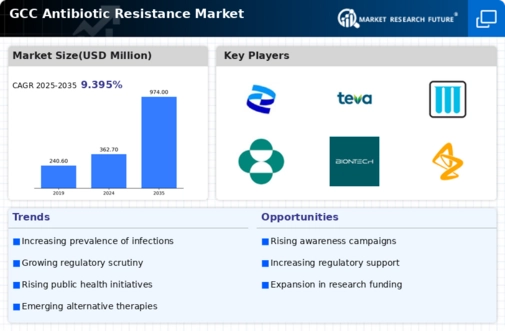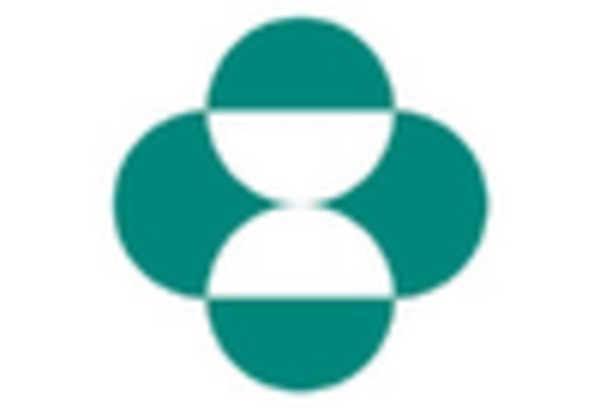Rising Healthcare Expenditure
The increasing healthcare expenditure in the GCC countries is a significant driver for the antibiotic resistance market. As healthcare budgets expand, there is a growing focus on addressing antibiotic resistance through improved healthcare infrastructure and access to advanced medical treatments. Reports suggest that healthcare spending in the GCC is projected to reach $104 billion by 2025, with a portion of this investment directed towards combating antibiotic resistance. This trend indicates a shift towards prioritizing infectious disease management, which is likely to enhance the antibiotic resistance market. The influx of funds may facilitate the development of new antibiotics and support educational campaigns aimed at reducing antibiotic misuse.
Government Initiatives and Funding
Government initiatives aimed at combating antibiotic resistance are significantly influencing the antibiotic resistance market in the GCC. Various health ministries are implementing national action plans to address this pressing issue, which includes increasing funding for research and development. For instance, the GCC governments have allocated substantial budgets to support initiatives that promote the responsible use of antibiotics and enhance surveillance systems. This proactive approach is expected to foster collaboration between public and private sectors, leading to advancements in antibiotic development and resistance management. The antibiotic resistance market stands to benefit from these investments, as they create a conducive environment for innovation and the introduction of new products.
Advancements in Diagnostic Technologies
Advancements in diagnostic technologies are playing a pivotal role in shaping the antibiotic resistance market. The introduction of rapid diagnostic tests enables healthcare providers to identify resistant pathogens more efficiently, leading to timely and appropriate treatment decisions. This technological progress is crucial in the GCC, where the burden of antibiotic resistance is escalating. The antibiotic resistance market is likely to experience growth as healthcare facilities adopt these innovative diagnostic tools, which can reduce the unnecessary use of antibiotics and improve patient outcomes. Furthermore, the integration of artificial intelligence in diagnostics may enhance the accuracy and speed of resistance detection, further driving market expansion.
Increased Collaboration Among Stakeholders
Increased collaboration among stakeholders, including governments, healthcare providers, and pharmaceutical companies, is emerging as a vital driver for the antibiotic resistance market. This collaborative approach aims to address the multifaceted challenges posed by antibiotic resistance through shared resources and expertise. In the GCC, partnerships are being formed to facilitate research initiatives and promote the responsible use of antibiotics. Such collaborations are expected to lead to the development of comprehensive strategies that encompass prevention, surveillance, and treatment. The antibiotic resistance market is likely to benefit from these synergies, as they foster innovation and accelerate the introduction of effective solutions to combat antibiotic resistance.
Growing Incidence of Antibiotic-Resistant Infections
The rising incidence of antibiotic-resistant infections in the GCC region is a critical driver for the antibiotic resistance market. Reports indicate that antibiotic resistance is responsible for approximately 700,000 deaths annually worldwide, with a notable share attributed to the GCC. The increasing prevalence of multi-drug resistant pathogens necessitates the development of new antibiotics and alternative therapies. This situation compels healthcare systems to allocate more resources towards combating antibiotic resistance, thereby stimulating market growth. The antibiotic resistance market is likely to see a surge in demand for innovative solutions, including novel antibiotics and rapid diagnostic tools, as healthcare providers seek to address the escalating threat posed by resistant infections.

















Leave a Comment